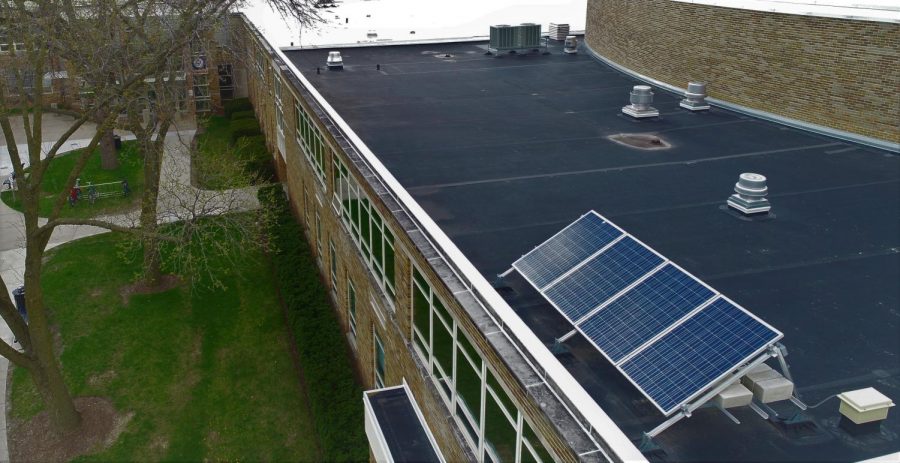The Building’s Energy
Libertyville High School has several solar panels installed on the northeast corner of the building, which were put in place seven years ago. These current panels do not generate a significant amount of electricity for the school.
Libertyville High School’s building offers space to students, staff and guests for a wide range of activities throughout the entirety of the year. To hold activities such as academics, extra curriculars, sports and dances, the building itself has complex resource and maintenance demands to ensure the building functions and can be a suitable space for such activities. Due to this, the building goes through continuous upgrades to achieve goals such as creating increased energy efficiency, updating maintenance systems and enhancing the experience for everyone throughout the building.
One of the largest recent updates to the school was the Olympic-sized pool with roughly 740,000 gallons of water, as described by Chris Stancil, supervisor of buildings and grounds at LHS. The size of the new pool is not the only difference it bears from the old one, though. Mr. Stancil explained that this pool is not only much more energy efficient but now also offers better protection against chloramines, which are gases that are created when people enter the pool with products such as aftershave or makeup on. LHS’s previous pool was installed in 1969, and Mr. Stancil explained how even though there were upgrades to the previous pool, its energy inefficiencies were abundant due to the age of its systems.
“This new pool has a scavenging system that actually takes the air, pushes it from one side to the other in the gutter system and removes most of the gases that come up out of the water,” Mr. Stancil explained. He also added that “it really is a phenomenal pool” as the district built it “keeping in mind safety and water quality and the health of the pool itself.”
Using newer maintenance systems is one way energy is more efficient in the new pool. One other contributor is the usage of LED lights. These lights are also being actively distributed throughout the entire school whenever possible due to their energy saving qualities.
LEDs, or light-emitting diodes, are more expensive than traditional light bulbs, but they also last longer while simultaneously requiring less energy. The U.S. Department of Energy describes the lights as “one of today’s most energy-efficient and rapidly developing technologies.”
Dave Lapish, English teacher and head of LEAF, shared that additional efforts of energy efficiency through lighting can be seen through the timers that most classroom lights now run on. He described that “teachers can set them at a certain time, so if you leave the room, it’ll go off automatically to flip the lights off.”
Two spaces that were recently outfitted with LEDs are the new dance studio and multipurpose room. Sitting in the location of the old pool, Mr. Stancil estimated that the lighting set up within these rooms now draws only “a 20th or 40th of the power” that the old pool lights required. Regardless of the exact numbers, Mr. Stancil guaranteed that the area is now “drawing less than 20% for electrical power” in comparison to the previous demands of that large space.
Not only do these rooms have LED lights, but according to Mr. Stancil, due to these being new additions to the school, they have a new air-handling system alongside a new mechanical room, which hosts up-to-date energy efficient equipment.
While the pool, dance studio and multipurpose rooms are now finished and usable projects, the next step for building updates is to give the fieldhouse new life. Currently, LHS’s largest open athletic venue doesn’t have air conditioning and has poor roofing, leaving it due for upgrades.
Dan Stanley, District 128’s assistant superintendent for finances, explained that this project has three major focuses: new roofing, new flooring and updated HVAC (heating, ventilation and air conditioning) systems.
When describing this project, Mr.Stanley explained that in order to remain cost efficient, the footprint of the space will be kept the same as updates are made. Mr. Stancil described it as stripping back “to the bare bones structure of the building itself” while maintaining the basic foundation of the space. In Mr. Stanley’s words, “It’s not going to look terribly different, but it will function much better.”
Though projects are often worked on during the summer in order to be completed before the return of school, Mr. Stancil explained that the size of this project will demand more time, leaving it to potentially not be finished until October.
The space will be more energy efficient since the outside walls and roof will be updated to have thicker insulation to protect against the heat or the cold from the outside coming in too easily. Additionally, the new roof will last for 30 or 40 years, which Mr. Stancil explained “will be great for the environment,” as it won’t require being changed as often.
As previously mentioned, air conditioning will be added into this part of the building, alongside LED lights and an updated air filtration system. Mr. Stancil explained that Covid-19 has put a larger emphasis on the importance of air filtration and due to that, the school will be making efforts to update air filtration throughout the entire building.
The idea for a larger expansion of improved air filtration is still in the early stages, but Mr. Stancil shared that the “air quality in the school will be much better” and “second to none” when these updates are made. Said updates would feature updating to a higher MERV (Minimum Efficiency Reporting Value) filter that would be able to filter out more articulations and potentially dangerous substances from the air.
Another initiative for building improvement that is currently waiting to be acted upon further is the usage of solar panels. Mr. Stancil explained that currently “we have five solar panels on the southeast corner of the roof” that were added “about seven years ago as an incentive to the school district.” These panels are essentially comparable to a “trial run” before the school takes larger scale action. Mr. Lapish described them as “sort of like the down payment or the beginning of the process.”
According to Mr. Stancil, “solar power is actually something that the district is seriously considering doing on the northeast corner of the building.” The effort of expanding this project though is challenged by the roof strength that the panels demand.
The amount of money it would take to redo and reinforce all of the school’s necessary roofs in order to add a substantial amount of panels at one time is not in the budget, according to Mr. Stanley. While a large-scale update in solar panels does not seem imminent, roofs continue to be updated throughout the school and whenever it’s possible, they are being reinforced to the point where they could support solar panels in preparation for the future.
The five solar panels set up today do not have a large impact on the energy usage of the school, as Mr. Stancil explained that they only generate about enough electricity to power two curling irons. The panels currently act more as an incentive to continue pushing solar energy into LHS’s future.







